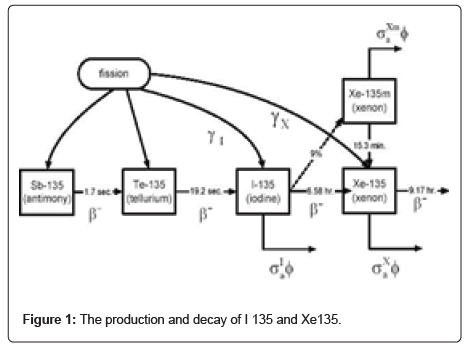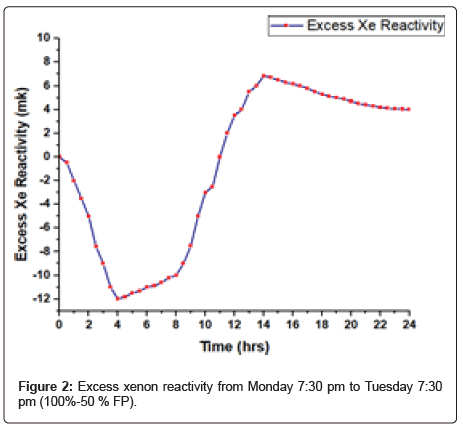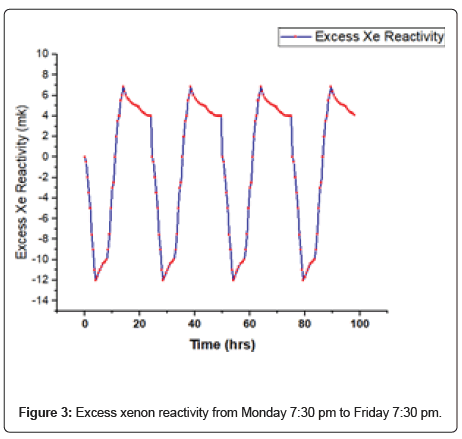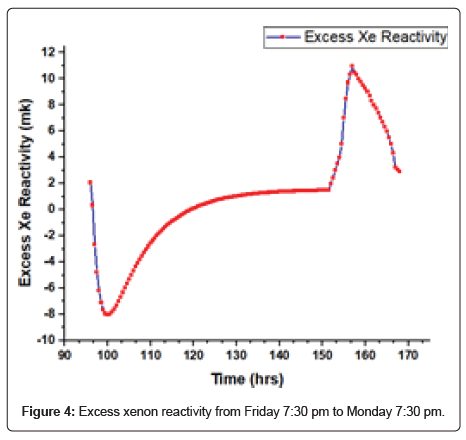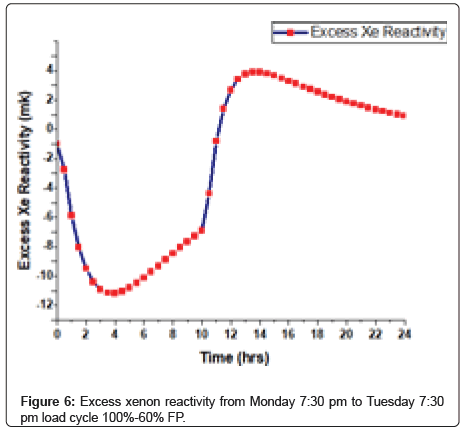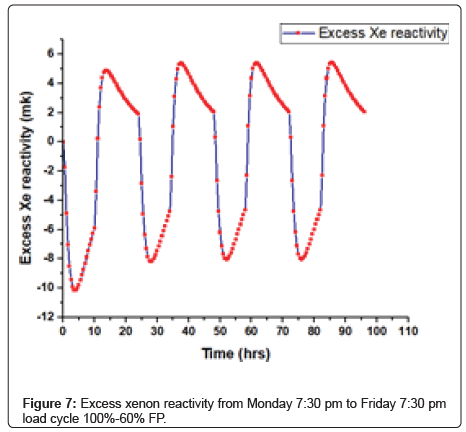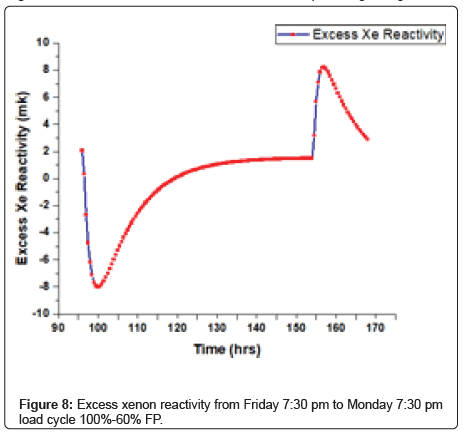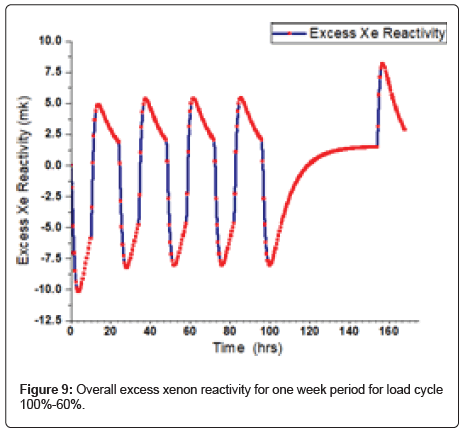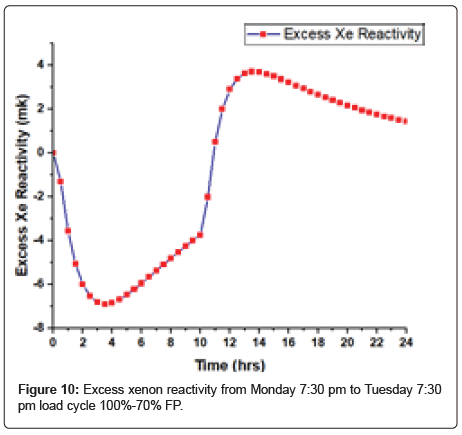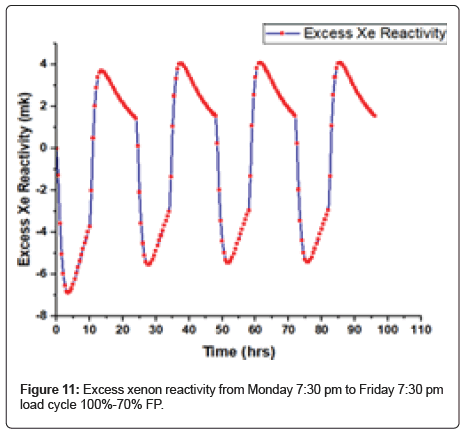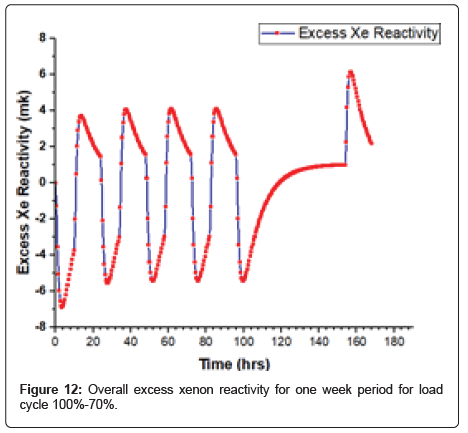Research Article, J Nucl Ene Sci Power Generat Technol Vol: 10 Issue: 11
Effect of Xenon Oscillations on CANDU Power Cycles
G Divya Deepak* and Atul
Department of Mechanical Engineering, Alliance University, Chikkahagade Cross, Chandapura Anekal Rd, Bangalore, India
*Corresponding Author:
G Divya Deepak
Department of Mechanical Engineering,
Alliance University,
Chikkahagade Cross,
Chandapura Anekal Rd,
Bangalore,
India,
E-mail: divyadeepak77@gmail.com
Received date: November 02, 2021 Accepted date: November 17, 2021 Published date: November 24, 2021
Citation: Divya Deepak G, Atul, et al., (2021) Effect of Xenon Oscillations on CANDU Power Cycles. J Nucl Ene Sci Power Generat Techno 10:11.
Abstract
Abstract:
In this research work, the effect of Xenon poisoning in a Canadian Deuterium Uranium (CANDU) reactor for different load cycles has been examined. The three load cycles that have been analyzed are 100%-70% full power, 100%-60% Full Power (FP), and 100%-50% FP. It is considered that the CANDU reactor has operated for a full week on a particular load cycle and the maximum excess of Xenon reactivity that accumulated in the reactor during the load cycle has been estimated. After calculating the excess Xenon reactivity in a load cycle, it has been analyzed whether it is within given reactivity limit (-18 to +7 mk) provided by devices which include liquid zone controllers, absorbers and adjusters in a CANDU reactor. Further it has been also mentioned as to what are options of controlling the reactor power if this excess reactivity exceeds the limit supplied by adjusters, absorbers and liquid zone controllers. With the results of the mathematical analysis of Xenon and Iodine concentration the optimized load cycle on which the CANDU reactor should be operated has been estimated. The impact of all the three power cycles on the uranium fuel is also studied.
Keywords: CANDU; Excess Xenon Reactivity; load Cycle
Introduction
Xenon is a noble gas that has an atomic number of 54 and an atomic mass of 131.3 g/mol. It has nine stable isotopes and seven known radioactive isotopes [1]. During a nuclear fission reaction process, a fissile nuclear fuel such as U-235 undergoes a chain of reactions as a result of capturing a thermal neutron. The captured neutron distorts the U-235 nucleus, and the electrostatic repulsion force overcomes the nuclear attraction causing a split into two fission fragments [2-5]. This process is accompanied by energy release in the form of gamma rays as well as neutron emission. Some of the neutrons are released spontaneously while smaller numbers are delayed due to radioactive decay of certain fragments. The fission process produces several neutrons that play major role in sustaining the chain reactions. The fission process releases fragments of different mass numbers mainly around 90 and 140, most of which are radioactive [6-7]. These fission fragments would decay, each with different half-life, to reach stable end products. Therefore, there would be a series of fragments decay that are inevitable. It is important to keep the chain reaction sustained to ensure neutrons growth to the desired level to deliver the required power output. One critical stage of the fission reaction is the formation of I-135, a subsequence of Te-135 beta decay. The I-135 is a weak neutron absorber and has a half-life of 6.7 hours. The beta decay of I-135 to Xe-135 introduces a very powerful neutron absorber product. Xe-135 has a large cross section of 2.6 million barns. [8] This is about 5128 times higher than the thermal cross-section of U-235, which are 507 barns [9]. A barn is equivalent to 10-28 m2. This makes it an effective neutron absorber with a high interaction probability with the thermal neutrons. Xe135 is produced with about 5% probability from every fission process but with 95% probability from I-135 decay. [10-12] Xe-135 has a half-life of 9.1 hours. Increment in Xe-135 concentration in the reactor stops the neutron growth due its large cross-section. Absorption causes the formation of a stable isotope, Xe-136 [7]. The neutron population decreases, and the chain reaction stops. The reactor eventually shuts down due to Xenon accumulation. Understanding how to deal with the produced Xe-135 is essential to keep the reaction chain sustainable and the neutron flux at desired rate.
When operating a new reactor, the startup stage initially has no trace Xenon, and the reactor is maintained critical at a low power level. Small traces of Xe-135 are detected afterwards as a direct product of fission process. As the power level is increased, Xe-135 starts to build up. It eventually reaches an equilibrium level. [13] Negative reactivity is delivered due to Xe-135 growth, and it is proportional to the power level. To maintain criticality, the control rods (absorbers) are withdrawn so the reactor remains critical. This keeps the negative impact of the Xe135 under control. The destruction of Xe- 135 occurs mainly via neutron absorption. Most of it is burned off due 2 to neutron flux forming Xe-136 (weak absorber) and the rest due to beta decay forming Cs-135 [14]. The mathematical analysis presented in this research work rigorously predicts the onset of Xenon oscillations for different power cycles in a CANDU reactor. Explicit formulas giving the effects of Xenon and Iodine concentration on the equilibrium negative reactivity of CANDU reactors. This study reflects the influence of the Xenon concentration on the CANDU load cycles. Xenon is the fission product which the most important for spatial oscillations because of its large thermal cross section (2.8 × 106 barns) for neutrons [15-17]. In thermal reactors the effect on reactivity is so huge that Xenon is known and implemented in reactor design since it was first found through reactivity reduction in Hansford reactor. Typically, Xenon is responsible for 2%-3% loss in reactivity following a few hours of full load operation. Xenon is found to have caused large reactivity transients in the reactor core when the total power is altered. Hence, it’s imperative to understand the effect of Xenon poisoning while operating the reactor in different load cycles. In this research work it is examined whether the excess reactivity due to Xenon transients is within the limit of reactivity devices of the CANDU reactor which include liquid zone controllers, absorbers and adjusters that provide inherently a reactivity control between -18 to +7 mk.
Xenon Effects on Nuclear Reactor Reactivity
Xenon is a major problem in CANDU reactors because of its remarkable neutron absorption and high yield [1]. About 6.6% of all fissions produce a nuclide of Xe135, either directly as a fission product or indirectly as a fission product daughter. [2-5]. Xe135 is produced directly in only 0.3% of all U235 fissions as shown in the equation below

Xenon-135 is mainly produced as a fission product daughter by Iodine decay as follows:

Iodine-135 is produced in 6.3% of U-235 fissions. Thus, Iodine decay accounts for about 95% of total Xenon production. (6.3/6.6=0.95). I-135 does not absorb neutrons. The production and decay of I-135 and Xe135 is shown in the Figure 1.
Accumulation of poisons in the fuel tends to reduce the multiplication factor which, in turn affects the reactivity. All the neutron poisons sooner or later reach an equilibrium level in a reactor core representing the balance between production and elimination due to decay and/ or absorption. Each of the poisons has a different impact on reactor operation. 135Xe, with its extremely high absorption cross-section of 2.65 × 106 barns is “used up” quickly upon creation, transmuting into 136Xe, which is a stable isotope. 135I has a longer half-life of 6.57 hours and, since its capture cross- section is about 80 barns, it reaches a higher equilibrium concentration while the reactor is operating. 135I eventually decays to 135Xe. 135Xe in turn has a half-life of 9.17 hrs [2]. Concentrations of Iodine and Xenon can be calculated using equations 1 and 2 respectively [3,4].
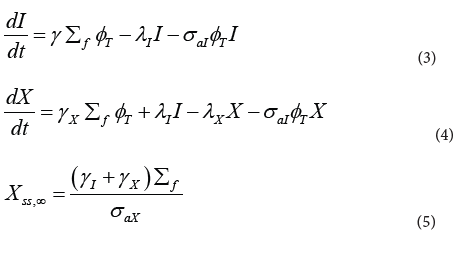

Where: γI is the Effective yield of Iodine135 per fission of U235, Σfis thermal fission cross section, ∅T is reactor neutron flux, λI is decay constant of Iodine135 , σaI is the absorption cross section of Iodine135 , σaX is the absorption cross section of Xenon, X is the concentration of Xenon135 ,γX is the effective yield of Xenon, λX is the decay constant of Xenon, XSS is the steady state concentration of Xenon, X(current) is the current concentration of Xenon at new power level, -28 is equilibrium negative reactivity provided by Xenon at full load for CANDU reactor which is taken as reference value for calculating excess Xenon reactivity.
Numerical Discussion
The following schedule of load for a week was considered in understanding three different load cycles, initially CANDU reactor is assumed to be at full power at Monday 7:30 pm then power is reduced in steps of 30 minutes till it reaches required reduced power level by Monday 8:30 pm. This reduced power level is kept constant till Tuesday 5:30 am. After which this power level is again stepped up to full power in steps of 30 min. Now the reactor is operated at this full power level from Tuesday 6:30 am to Tuesday 7:30 pm. This cycle is continuously repeated for all the remaining days in the week.
Load cycle of a CANDU reactor 100%- 50% Fp
In this load cycle we have varied the reactor power from 100 to 50%FP during the load cycle of a week. We have calculated the Iodine concentration, Xenon concentration, and also excess xenon reactivity during the load cycle. At the end of first 24 hours of operation, i.e., on Tuesday 7:30 pm the maximum xenon reactivity is +6.85 mk. This excess positive reactivity can be brought in control using liquid zone controllers which provides +3 mk to -3 mk reactivity by raising the level of light water in the zones and by using boron poison in small concentration of 0.1 ppm The excess xenon reactivity for the first time period from Monday 7:30 pm to Tuesday 7:30 pm as shown in Figure 2.The excess xenon reactivity for the first time period from Monday
7:30 pm to Friday 7:30 pm as shown in Figure 3. The maximum excess
Xenon reactivity during this period is +7.48 mk. Since maximum excess Xenon reactivity during 24 hr cycle is +7.48 mk and has exceeded control limits (-18 to +7 mk). So we have to insert the control absorbers for providing sufficient negative reactivity, total reactivity worth of absorbers is -10 mk. The excess Xenon reactivity reached for the entire week in the load cycle 100%-50%FP is given below in Figure 4. Ultimately in this 100%-50% FP load cycle the maximum Xenon
excess Xenon reactivity reached is on Monday 8:00 am it is +10.9785 mk, since the value of reactivity exceeds the given controllers like liquid zone, adjusters, boron poison (-18 mk to +7 mk), hence it is imperative to insert another control device called mechanical control absorbers whose total reactivity worth is around -10 mk. The excess Xenon reactivity reached for the entire week in the load cycle 100%- 50% FP is given below in Figure 5. Ultimately in this 100%-50% FP
load cycle the maximum Xenon excess Xenon reactivity reached is on Monday 8:00 am it is +10.9785 mk, since the value of reactivity exceeds the given controllers like liquid zone, adjusters, boron poison (-18 mk to +7 mk), hence it is imperative to insert another control device called mechanical control absorbers whose total reactivity worth is around -10 mk. This is not a practicable load cycle, since the value maximum excess xenon reactivity (+10.9785) exceeds the control limits (-18 to +7 mk) by more than +3.97 mk, it is must for us to insert the control rods for a longer period inside the reactor but usually for a good load cycle, the reactor should be maintained within the control limits of (-18 mk to +7 mk) using the zone controller, adjusters and poisons. Here in this load cycle is fuel temperature difference after step up of power 100% FP and after step down of power 50% FP is enormous this is not good for the fuel. Moreover, the uranium fuel should not be subjected to load cycle that involve large scale step down of power and step up of power, since these load cycles are followed on daily basis(24 hr cycle),after some years the fuel may start developing cracks this is because of thermal stress caused in the fuel due to enormous fuel temperature difference when the power is stepped up and when the power is stepped down on a daily basis (24 hr cycle). Here in this load cycle (100%-50%FP) the reactor cannot be always kept critical since the maximum excess Xenon reactivity +10.9785 mk has exceeded the control limits (-18 mk to +7 mk) of zone control, adjusters and poisons. So, another control device like control absorbers is used to provide sufficient negative reactivity.
There is a cosine curve pattern emerging as value of Xenon decreases initially during start of 24 hr load cycle when the power is increased and then goes to positive values when the power is decreased. Finally, again decreases and returns to its closer initial start value and it follows a cyclic pattern.
Load cycle of a CANDU reactor 100%- 60% Fp
In this case the reactor power is varied from 100% to 60% FP during the load cycle of a week. At the end of first 24 hours of operation, i.e., on Tuesday 7:30 pm excess Xenon reactivity is +4.88941386 mk as shown in Figure 6. This excess positive reactivity of Xenon can be
controlled by liquid zone controllers by raising the level of light water in the zones and by using boron poison in small concentration of 0.1 ppm. The excess xenon reactivity for the time period Monday 7:30 pm to Friday 7:30 pm is shown in Figure 7. The maximum excess
Xenon reactivity during this period is +5.4133 mk. this excess Xenon reactivity throughout this 24 hrs can be controlled by liquid zone controllers by raising the level of light water and produce sufficient negative reactivity and also by using boron poison and liquid zone control of 0.4 ppm for the maximum excess negative reactivity during the cycle 100%-60% FP. there is cosine curve pattern emerging as value of xenon decreases initially during start of 24 hr load cycle when the power is increased and then goes to positive values when the power is decreased. Finally, again decreases and returns to its closer initial start value. It follows a cyclic pattern. The load cycle 100%-60% FP for the time period Friday 7:30 pm to Monday 7:30 pm is shown in Figure 8. The maximum excess Xenon reactivity during this period is
+8.20 mk, happens on Monday 8:30 am, this excess Xenon reactivity is greater than the allowed limits provided by liquid zone, adjusters and boron poison i.e., (-18 mk to +7 mk). Hence this excess xenon reactivity can be controlled by inserting the control absorbers, which has total reactivity worth of -10 mk. The excess Xenon reactivity reached during entire week for the load cycle 100%-60% FP is shown in Figure 9. this not a practicable load cycle since in this 100%-60% FP
load cycle the maximum Xenon excess Xenon reactivity reached is on Monday 8:30 am it is +8.20 mk, since this value of reactivity exceeds the given controllers like liquid zone, adjusters, boron poison, control device such as mechanical control absorbers have to be inserted whose total reactivity worth is around -10 mk. Hence the reactor cannot be kept critical all times with the available control devices like zone control, adjusters and poison.
Load cycle of a CANDU reactor 100%-70% Fp
In this load cycle we have varied the reactor power from 100 to 70% FP during the load cycle of a week. At the end of first 24 hrs of operation, i.e., on Tuesday 7:30 pm excess Xenon reactivity reached is +1.40 mk as shown in Figure 10. The excess xenon reactivity during this time
period is +3.70 mk. This excess xenon reactivity can be controlled by liquid zone controllers by raising the level of light water in the zones and by using boron poison in small concentration of 0.1 ppm.
The excess xenon reactivity for the time period Monday 7:30 pm to Friday 7:30 pm is shown in Figure 11. For the load cycle 100%-
70% FP. The maximum excess Xenon reactivity during this period is +4.09 mk, this excess Xenon reactivity throughout this 24 hrs can be controlled by liquid zone controllers by raising the level of light water and produce sufficient negative reactivity and also by using liquid zone control of and boron poison of 0.4 ppm. The excess Xenon reactivity reached during entire week for the load cycle 100-60%FP is shown in Figure 12. In present load cycle (100%-70% FP), the
maximum value of excess xenon reactivity reached only +6.14 mk which is within the control limits (-18 mk to +7 mk) that is provided by the control devices like zone controllers, adjusters, and poison. this is a practicable load cycle than the previous load cycle (100%-60% FP) where the excess Xenon reactivity went up to +8.20 mk which is more than the allowed limits of control devices (-18 mk to +7 mk). Hence there is no necessity to use any other control devices other than zone controller, adjusters and poisons. The reactor can be always kept critical with the control devices like zone control, adjusters and poisons in this 100%-70% FP load cycle. In the Table 1,
| LOAD CYCLE | Xenon & I Maximum iodine concentra tion |
odine Concent Maximum xenon concentrati on |
rations Maximum Excess Xenon Reactivity(mk) |
|---|---|---|---|
| 100-50 % | 1.8*E14 | 2.3*E13 | +10.97 |
| FP | |||
| 100-60% | 2.1*E14 | 2.6 *E13 | +8.20 |
| FP | |||
| 100-70% FP | 2.3* E14 | 2.9*E13 | +6.14 |
Table 1: Xenon and Iodine concentrations
the maximum concentrations of 135I and 135 Xe are mentioned for different load cycles in a CANDU reactor here even though Xenon concentration increases as we increase power level it provides lesser negative reactivity. This is because of Xe 135 also is getting converted to Xe136 by absorbing neutrons. It is important to note that Xe136 is not a neutron absorber.
Conclusion
The 100%-50% FP is not a practicable load cycle, since the maximum value of excess Xenon reactivity (+10.9785 mk) exceeds the control limits (-18 to +7 mk) by more than +3.97 mk, hence it is must for us to insert the control rods for a longer period inside the reactor. But usually for a good load cycle, the reactor should be maintained within the control limits of (-18 mk to +7 mk) using the zone controller, adjusters and poisons. Here in this load cycle the temperature difference in fuel after step up of power 100% FP and after step down of power 50% FP is large which is not good for the fuel. Moreover the uranium fuel should not be subjected to load cycle (100%-50% FP) that involve large scale step down of power and step up of power, since these load cycles are followed on daily basis (24 hrs cycle), after some years the fuel may start developing cracks due to the thermal stress produced in the fuel due to enormous fuel temperature difference when the power is stepped up and when the power is stepped down on a daily basis (24 hrs cycle). The 100%-60% FP is also not a practicable load cycle. In this load cycle the maximum excess Xenon reactivity reached is +8.20 mk, since this value of reactivity exceeds the given controllers like liquid zone, adjusters, boron poison, we need to insert another control device called mechanical control absorbers whose total reactivity worth is -10 mk. Hence the reactor cannot be kept critical all times with the available control devices like zone control, adjusters and poison. Out of three load cycles which were performed it was found that the 100%-70% FP power cycle is where the reactor can be always kept critical. In this load cycle maximum excess Xenon reactivity reached is only +6.149345 mk only, which is within the control limits (18 mk to +7 mk) of zone controllers, adjusters and poison.
References
- J.R Lamarsh., Introduction to Nuclear Engineering, Ed 2, Addison-Wesley Pub. Co.1983.
- S .Glasstone, Nuclear Reactor Engineering,Ed 3, Van Nostrand, USA.1981.
- A.R. Foster and R.L Wright,, Basic Nuclear Engineering,Ed 3, Allyn and Bacon, USA.1977.
- J.J., Duderstadt, Nuclear Reactor Analysis, Ed 1, Wiley.1976.
- Corcoran W. R., Humphries, J. R., & Litke, H. J.Damping of Xenon Oscillations in the Maine Yankee Reactor. Nuclear Technology.1974;22, 252-262.
- Shan, J., Chen, W., Rhee, B. W., & Leung, L. K.et al.Coupled neutronics/thermal–hydraulics analysis of CANDU–SCWR fuel channel.Annals of Nuclear Energy.2010;37(1):58-65
- Stacey, W. M. (2007). Nuclear Reactor Physics. John Wiley & Sons.
- Bickel, J. H. (2001). Grid Stability and Safety Issues Associated with Nuclear Power Plants. Evergreen Safety and Reliability Technologies Engineering, Ed 3, Van Nostrand, USA.1981.
- A.R. Foster and R.L Wright,, Basic Nuclear Engineering, Ed 3, Allyn and Bacon, USA.1977.
- J.J., Duderstadt, Nuclear Reactor Analysis, Ed 1, Wiley.1976.
- J. Canosa, H. Brooks, Xenon Induced oscillations, Nucl. Sci.Eng.1966; 26, 237.
- P. Reuss, Neutron physics (EDP Sciences, Les Ulis.2008; 696
- Y. Shimazu, Continuous guidance procedure for xenon oscillation control, J. Nucl. Sci. Technol.1995; 32, 1159.
- C. Lin, Y. Lin, Control of spatial xenonoscillations in pressurized water reactors via the kalman filter, Nucl. Sci. Eng.1994; 118, 260.
- L. Pease and R. Wilson: "Pressurized Heavy- Water Reactor Safety", Atomic Energy ofCanada Limited Report AECL-5520, September.1977.
- M.H.M. Roshd: "The Physics of CANDU Reactor Design", Atomic Energy of Canada Limited Report AECL-5803, April.1977
- D. RANDAL and D.S. ST. JOHN, “Xeon Spatial Oscillations,” NUCLEONICS, A McGraw-Hill Publication.1958; 82-87.
 Spanish
Spanish  Chinese
Chinese  Russian
Russian  German
German  French
French  Japanese
Japanese  Portuguese
Portuguese  Hindi
Hindi 